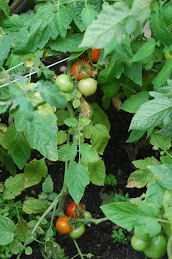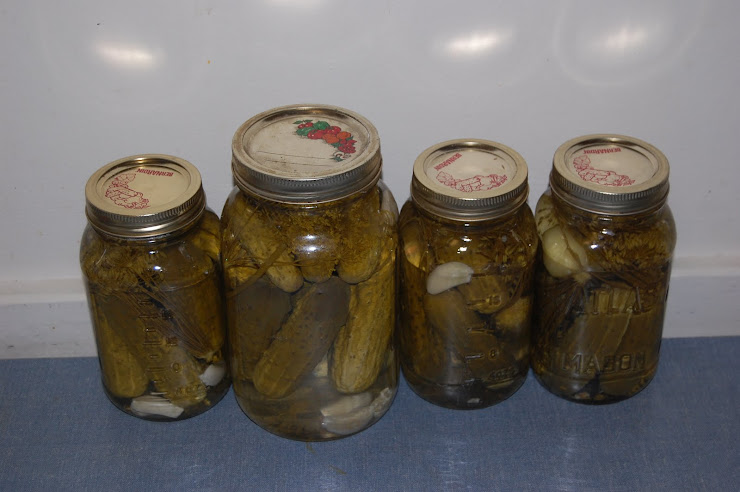
Three potatoes! That's my entire crop from the potatoes in a bucket. Or in this case, garbage can. And since I actually planted 5 ( 3 purple, 2 banana fingerlings), I say that was a loss. Thankfully the pail didn't take up much in the way of garden real estate and the mountain of soil can now be added to the garden bed but it's still a bit disappointing. I'm not sure why they didn't produce; I had lovely, apparently healthy potato plants until about two weeks ago. They hadn't flowered but I wasn't too worried yet. Then one day I noticed that all the new growth was turning yellow and wilting. I had a closer look and saw millions of sow bugs living in the pail - we've had an unusual amount of those critters this year. They normally live on dead and decaying matter and can be very helpful in composting larger stuff like sticks. But they can and will eat living organic matter if the opportunity arises. They've been nibbling on any beans that touch the soil this summer and I don't know if they were responsible for the original holes in my eggplants but they sure made themselves at home in them.
I can't see what would be appetizing about the roots of a potato plant but when I pulled the plants out yesterday there were no roots to speak of and they were mushy at the soil level. I suspect it may also have been a drainage issue- I used an old metal garbage pail which I thought was already leaky so didn't put drainage holes in it. I lined it with a garbage bag, with holes in the bag and a drainage layer beneath it but when I emptied it there was a fair amount of water and the smell of rot was apparent. So perhaps I am maligning the sow bugs in error and they were actually doing me a service by eating the rotted plants. The three potatoes don't appear to be munched on and I didn't find any half eaten ones. I guess we'll be buying potatoes as usual this winter- thankfully local potatoes are abundant and inexpensive.

On the plus side I have a bumper crop of soybeans this year. We've been eating them fresh all summer and now I'm freezing batches of edamame for snacking all winter. I'm also harvesting lots of peppers, both hot and sweet and a decent crop of tomatillos. The tomatoes are still producing lots but fall is just around the corner so it's time to make salsa and pickled jalapenos and all those spicy preserves that will keep us warm all winter!





 One of our favourite ways to serve fresh tomatoes is a modified caprese salad, using fresh Ontario peaches, along with tomatoes, buffalo mozzarella, and basil. Drizzled with olive oil and a splash of balsamic, the sweet tastes of summer explode in your mouth!
One of our favourite ways to serve fresh tomatoes is a modified caprese salad, using fresh Ontario peaches, along with tomatoes, buffalo mozzarella, and basil. Drizzled with olive oil and a splash of balsamic, the sweet tastes of summer explode in your mouth!























.jpg)



